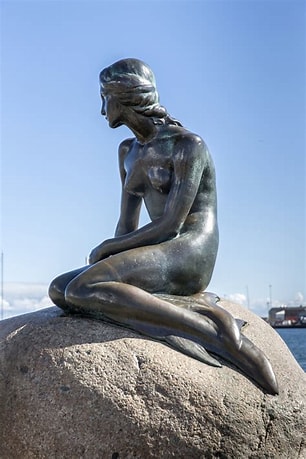-by Katie Green – www.katiegreenstories.com
I have loved fairy tales ever since I can remember. These stories talked about things that were important. Maybe that’s what I’m a storyteller today.
I spent most of my childhood summers with my grandparents in Meadowview, Virginia. The women snapped peas and broke beans on the front porch, and they told stories about their lives and their neighbors. But after dark, when the dishes were washed and put away, the family sat on the slip-covered sofa and chairs. Aunt Mabel pulled out books and read to me. The stories of Grimms Brothers and Hans Christian Andersen came to life, as Mother knit, grandma crocheted, and the men hid behind newspapers – pretending not to listen.
One story I repeatedly asked my Aunt Mabel to read was Hans Christian Andersen’s The Little Mermaid. My little sister, Jo Ann, died of childhood leukemia when I was seven, and The Little Mermaid story was the story that explained death for me. It was much more satisfying than any of the other explanations I had been given. I knew that Jo Ann was a star in heaven, just like the Little Mermaid.

If you are puzzled, you are probably thinking of Walt Disney’s version of this story. In Andersen’s story, the Merqueen explained death. She said that Mer people live for three hundred years and then turn into sea-foam, and Poof! Life is over. But – she explained – human beings have something called a soul. “When a human being dies, the soul separated from the body and goes into the starry heavens forever.” When the Little Mermaid learned this, she declared that she would gladly trade all of her three hundred years if she could spend just one day as a human and then live forever among the stars.
The Merqueen further told the Little Mermaid that there is only one way that a merperson can become a human being: that is to marry one. “During the marriage ceremony, the human being’s soul bubbles up and spills onto the merperson.” (What a beautiful explanation of marriage!) Then, according to the Merqueen, the merperson has a soul and is a human being. In Andersen’s story, the prince is a vehicle to the Little Mermaid’s long-term goal, which is to live in the starry heavens forever.
The original Andersen tale puts another interesting twist into Disney’s simplified version: The Merqueen gave her granddaughter misinformation. The prince does not marry the mermaid, and yet, because of her compassion, she ends up in the starry heavens. As a child, I found this conclusion quite satisfying. I still do.
Many people shy away from Andersen, saying, “He’s much too dreary.” And, yes, there is the problem of the Little Mermaid becoming mute when she is a human being. As a child, I wondered why the Little Mermaid didn’t write or use sign language. As an adult, the metaphor is clear. I know the agony of not speaking my mind – for whatever reason. And Andersen said, “That makes the suffering all the deeper.” Andersen’s Little Mermaid feels like she is walking on knives “so sharp the blood must flow.” How many of us have tip-toed around situations on pins and needles, or have felt as though we are “walking on eggs?
While the Disney version of classic fairy tales can be entertaining, I believe that the original versions contain the essence of life. As parents, we have a desire to protect our children from the darker side of fairy tales – sexism, violence, revenge, death. But young people are familiar with the plots in fairy tales. Children know about oppression, even though they may not be able to name it. We are only trying to live our own version of a fairy tale if we tell only saccharine versions of these time-honored stories. Exposing children to more than one version of the same story opens up space for questions and dialogue. This promotes critical thinking and literacy.
As a child, I played “prince and princess with my friend Connie Oliveros. We must have acted out Sleeping Beauty and Beauty and the Beast a hundred times. We even played Little Mermaid. What better way to examine our awe and curiosity about relationships? The wicked stepmother, the fairy godmother, the thorny vines, the uninvited thirteenth fairy, the prince. We were all of the characters, and all the events happened to us as we played inside the house in Houston, Texas, venetian blinds tightly closed, dimming the room and keeping out the heat of the day.
I am in favor of telling the old tales as they were read to me in the 1940’s. These stories do not tip-toe. The archetypes are bold. Fairy tales are metaphors for life. They give us opportunities to think and question.

Katie Green brings the heart of the story to the heart of the listener.
Her tales of Truth, Folk & Faery have delighted audiences from coast to coast and beyond. She believes that storytelling can and does change the world. Katie is a member of the Florida Storytelling Association, Old Tampa Bay Storytellers, NEST, and the National Storytelling Network (NSN). She is one of the founding members of the League for the Advancement of New England Storytelling (LANES – now known as NEST).
Want to contribute a story to the FSA blog? Send a note to wbelcher47@yahoo.com
